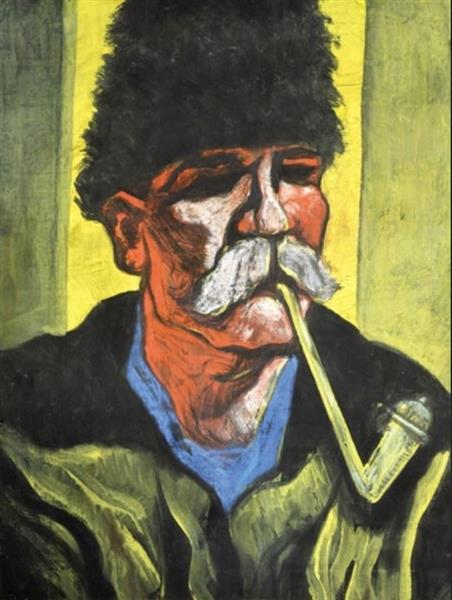Description
The painting "Pipe ferfi" by Hugó Scheiber, a prominent representative of the Fauvista Movement in Hungary, is a vibrant testimony of the fusion between abstraction and figurative representation. The work encapsulates the essence of color and light, distinctive of Scheiber's style, which allows the spectator to immerse himself in a sea of emotions that emerge through his vibrant palette.
In "Pipe ferfi", the artist presents a male figure that stands in the foreground, surrounded by a background of rich and saturated tones. The composition is characterized by a bold use of colors, which not only define the shape and volume, but also establish an emotional dialogue between the subject and its environment. Scheiber uses warm and cold colors in a deliberate harmony, where red and blue evoke an atmosphere of contrasts, worthy of fauvistas ideals. The male figure is treated in a stylized way, with expressive contours that provide a sense of movement and dynamism.
Through his technique, the artist manages to confuse the borders between the figure and the background, turning the work into an enveloping visual experience. The character of the character, despite being in a somewhat schematic representation, transmits an emotional complexity that invites introspection. This approach is characteristic of Scheiber's style, who, during his career, explored various facets of the portrait in vibrant and colorful contexts.
Another notable feature of this painting is lighting, which seems to emanate from the palette itself, suggesting a kind of internal light that bathes both the figure and its surroundings. This conception of light, far from being naturalistic, becomes a vehicle to express feeling and mood, a fundamental aspect in Fauvism, movement to which Scheiber was strongly associated.
While "Pipaó Férfi" may not be Scheiber's best known work, it is located in a context where its exploration of shapes and colors resonates with the proposal of other exponents of the artistic avant -garde of its time. His study of color and his ability to synthesize the human figure in an almost abstract language connect it with other European painters who experienced with perception and reality.
The figure of man, although it is not detailed precisely, represents an emblematic search for male identity in its cultural context, a recurring theme in Scheiber's work. This approach to the human figure and its interaction with the environment reveals a deep reflection on being and its context, universal issues that transcend the time they were created.
In conclusion, "Pipaó Férfi" is an eloquent example of Hugó Scheiber's talent to combine color, shape and emotion. The work not only offers a window to its inner world, but also invites the viewer to reflect on the connection between the individual and the surrounding environment, becoming a key piece within the visual dialogism of modern art. Its ability to cause an emotional response through abstraction and the figure reminds us of the richness of pictorial language and the relevance of art in our understanding of humanity.
KUADROS ©, a famous paint on your wall.
Hand-made oil painting reproductions, with the quality of professional artists and the distinctive seal of KUADROS ©.
Art reproduction service with satisfaction guarantee. If you are not completely satisfied with the replica of your painting, we refund your money 100%.

